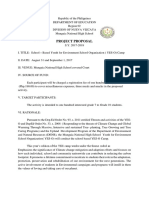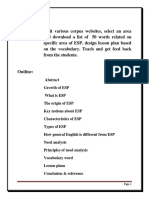Rationale SIP
Rationale SIP
Uploaded by
Maria Victoria PadroCopyright:
Available Formats
Rationale SIP
Rationale SIP
Uploaded by
Maria Victoria PadroOriginal Description:
Copyright
Available Formats
Share this document
Did you find this document useful?
Is this content inappropriate?
Copyright:
Available Formats
Rationale SIP
Rationale SIP
Uploaded by
Maria Victoria PadroCopyright:
Available Formats
Rationale
R.A. No. 9155 – Chapter 1, Section 7
Consistent with the national education policies, plans and standards, the school heads shall
have authority, accountability and responsibility for the following:
1. Setting the mission, vision, goals and objectives of the school
4. Developing the school education program and school improvement plan
The School Improvement Plan (SIP) is a road map that establishes the changes that the
school needs in order to improve student achievement and that shows how and when these changes
will be made. It is a three-year education development plan that embodies the vision and mission
of Department that the school must embrace.
The SIP contains the profile of the school and the community, problems and needs, goals,
objectives, standards and targets, implementation plan, monitoring and evaluation plan,
communication and advocacy plan, documentation and reporting to stakeholders and signatories.
It is a comprehensive overview of major priorities to which the school will commit its resources
including activities which are supportive of the
The ultimate objective of the school improvement process is to achieve the desired learning
outcomes by enhancing the way curriculum is delivered by competent, committed and caring
teachers by creating a safe and a nurturing environment for learning, and by increasing the
stakeholders’ participation in the entire school improvement process.
It also aims to help school heads, teachers, parents and other stakeholders in the school
community participate in a continuous improvement process by identifying potential barriers to
improvement and by finding ways to move the school from where it is now to a condition in which
students can achieve their highest potential.
The process primarily requires constant analysis of school needs, planning and
implementing appropriate actions and monitoring and evaluating results and outcomes.
It also involves comparing existing school practices with those of others and obtaining
information about best practices in order to raise standards and ultimately improve school
performance.
You might also like
- Gender Equality and Social Inclusion (GESI)Document38 pagesGender Equality and Social Inclusion (GESI)Atilano Dumayas Jr.100% (6)
- School Planning Team Terms of Reference - 0Document1 pageSchool Planning Team Terms of Reference - 0Genecor R Caidic100% (2)
- Module 1 Output School Shared Vision - FINALDocument2 pagesModule 1 Output School Shared Vision - FINALRamil Galido100% (10)
- 2014 Aip Accomplishment ReportDocument2 pages2014 Aip Accomplishment ReportLeodigaria Reyno100% (3)
- School Based Selection CommitteeDocument1 pageSchool Based Selection CommitteeRodnel Moncera100% (1)
- Esip Pulo Es 2019-2022 (Refined)Document32 pagesEsip Pulo Es 2019-2022 (Refined)Julius Flores0% (1)
- Sip AcrDocument2 pagesSip AcrMarc Arvi Villadolid Quiroz100% (1)
- School-Based Inset 2020Document47 pagesSchool-Based Inset 2020Mhilgene Briones Manalo100% (4)
- School Finance Team TorDocument2 pagesSchool Finance Team TorGrace Music100% (1)
- Minutes of SPT MeetingDocument6 pagesMinutes of SPT MeetingHanie Balmedina-Razo100% (1)
- School Improvement Plan: I. Executive SummaryDocument15 pagesSchool Improvement Plan: I. Executive Summarymercy sacrizNo ratings yet
- Duties and Responsibilities of TeachersDocument11 pagesDuties and Responsibilities of TeachersRochelle Abrigo CaradaNo ratings yet
- Proposal of Yes-O CampDocument13 pagesProposal of Yes-O CampMaria Victoria Padro100% (27)
- DO 44 S. 2015Document3 pagesDO 44 S. 2015Derle Romo100% (4)
- PAP Accomplishment Report SampleDocument1 pagePAP Accomplishment Report SampleJhe-ann Dela Cruz100% (1)
- Monitoring Tool On Readiness of Basic Education Curriculum Implementation For Sy 2020-2021Document6 pagesMonitoring Tool On Readiness of Basic Education Curriculum Implementation For Sy 2020-2021san pablo elementary67% (3)
- Department of Education: Region Iv-A Calabarzon Division of BatangasDocument1 pageDepartment of Education: Region Iv-A Calabarzon Division of BatangasJovie Cuadra100% (1)
- Certification: Division of Cebu ProvinceDocument7 pagesCertification: Division of Cebu ProvinceBagamel YlananNo ratings yet
- List of CoordinatorshipDocument2 pagesList of CoordinatorshipAlbin John A. Lalaguna100% (2)
- Project Initiative Plan Sample LLNHSDocument14 pagesProject Initiative Plan Sample LLNHSSHIRLEY JEAN Sugano100% (1)
- OPCRF Ppt-HenryDocument23 pagesOPCRF Ppt-HenryRodel Agcaoili100% (1)
- Brigada LetterDocument2 pagesBrigada LetterLilibeth Escobal Ramos100% (2)
- School Improvement PlanningDocument11 pagesSchool Improvement PlanningAnne Dinopol-Malingin100% (3)
- Esip Appraisal and Review Tool 2Document2 pagesEsip Appraisal and Review Tool 2Leo Jasareno Hubilla83% (6)
- Narrative Report: Crafting of School Improvement PlanDocument1 pageNarrative Report: Crafting of School Improvement PlanFejj Eli100% (1)
- Chapter 1 SipDocument3 pagesChapter 1 SipCherlene Remo CagasanNo ratings yet
- Sip-Aip Monitoring Tool2Document8 pagesSip-Aip Monitoring Tool2brave29heart71% (7)
- Brigada Implementation PlanDocument2 pagesBrigada Implementation Plannelson100% (2)
- Banner Project StatusDocument2 pagesBanner Project StatusHaidee Daroy Apuya100% (4)
- Aip Review Template: Ppas Objectives Pis (Target) Actual Acomplishment Facilitating Factor Hindering FactorDocument3 pagesAip Review Template: Ppas Objectives Pis (Target) Actual Acomplishment Facilitating Factor Hindering FactorNeil Paolo Popelo100% (2)
- Enhanced School Improvement Plan: LCNHS-Silangang Mayao ExtensionDocument15 pagesEnhanced School Improvement Plan: LCNHS-Silangang Mayao ExtensionLourdes Moredo60% (5)
- LDM Practicum Portfolio School HeadDocument21 pagesLDM Practicum Portfolio School Headseniorhighschool talugtugnhs93% (30)
- DepED Order No.44 s.2015 - 0001Document3 pagesDepED Order No.44 s.2015 - 0001Jorge Bautista67% (3)
- MES SIP DepEd MatatagDocument33 pagesMES SIP DepEd MatatagSkul TV Show100% (1)
- Educate Children at Risk Factors Affecting Cohort Survival Rate - Cagape Final PaperDocument12 pagesEducate Children at Risk Factors Affecting Cohort Survival Rate - Cagape Final PaperDr. Wendell Glenn Cagape100% (16)
- Roles and Responsibilities of School Planning TeamDocument2 pagesRoles and Responsibilities of School Planning TeamRhodora Grace A Ranchez100% (5)
- Brigada Eskwela ReportDocument6 pagesBrigada Eskwela ReportJohn Eirhene Intia BarreteNo ratings yet
- Narrative BRIGADA ESKWELADocument3 pagesNarrative BRIGADA ESKWELABeverly Inopiquez MartinNo ratings yet
- Department of Education: Tapinac Elementary SchoolDocument2 pagesDepartment of Education: Tapinac Elementary SchoolDanilo dela Rosa100% (1)
- Accomplishment Report-AUGUST 2019Document3 pagesAccomplishment Report-AUGUST 2019Susan T. LaxamanaNo ratings yet
- Huwangan ES SIP DesignDocument16 pagesHuwangan ES SIP DesignAMALIA CAGAMPANGNo ratings yet
- Republic of The Philippines Region III Department of Education Division of San Jose CityDocument3 pagesRepublic of The Philippines Region III Department of Education Division of San Jose CityjarvinNo ratings yet
- School Brigada Pagbasa Monitoring ToolDocument4 pagesSchool Brigada Pagbasa Monitoring ToolPaul Bryan Bron100% (5)
- Suggested Contextualized School - Based Management Means of Verification Management of Resources Indicators Level 1 Level 2 Level 3Document3 pagesSuggested Contextualized School - Based Management Means of Verification Management of Resources Indicators Level 1 Level 2 Level 3Diana Marie Vidallon Aman100% (4)
- DO 27 S 2019 PDFDocument258 pagesDO 27 S 2019 PDFEduardo O. BorrelNo ratings yet
- Report of Teachers Observed and Given Assistance (Accomplishment Report) For The Month of April 2021 Dableston Elementary School SND WestDocument5 pagesReport of Teachers Observed and Given Assistance (Accomplishment Report) For The Month of April 2021 Dableston Elementary School SND WestAlera Kim100% (1)
- Aplaya NHS End of School Year Project Monitoring Report Form SY 2019 2020Document3 pagesAplaya NHS End of School Year Project Monitoring Report Form SY 2019 2020Hazel Villalobos Gesmundo100% (1)
- Edited Version Monitoring Tool For Checking TOS TQsDocument1 pageEdited Version Monitoring Tool For Checking TOS TQsChristian Opeña Ducusin100% (3)
- Revised School Based Management: Assessment Process and Tool (Apat)Document13 pagesRevised School Based Management: Assessment Process and Tool (Apat)Liberty Villanueva LugatocNo ratings yet
- SIP QA ToolDocument2 pagesSIP QA ToolAlain Capapas Maestrado100% (10)
- Smea Terms of Reference-2019Document2 pagesSmea Terms of Reference-2019Jacquiline Tan100% (1)
- Smepa ToolDocument41 pagesSmepa ToolJohn RexNo ratings yet
- Objectives Methods/Strategies Resources Time FrameDocument4 pagesObjectives Methods/Strategies Resources Time Framemycelyn90% (10)
- Brigada 2021 CommitteesDocument2 pagesBrigada 2021 CommitteesBimbo Cuyangoan100% (2)
- Sample Resolution On HandbookDocument2 pagesSample Resolution On HandbookLorenz Philip Arias100% (3)
- DALIG PPAs Accomplishment Report LONGDocument5 pagesDALIG PPAs Accomplishment Report LONGAiza Sillano100% (2)
- Inset Terminal ReportDocument1 pageInset Terminal ReportDecember Cool100% (2)
- ADM SLM Monitoring ToolDocument8 pagesADM SLM Monitoring ToolJulius Salas100% (2)
- Lac Plan For The Implementation of Elln Focusing On The Science of Reading - PiolDocument5 pagesLac Plan For The Implementation of Elln Focusing On The Science of Reading - PiolCharlee Ann Ilao100% (1)
- The School Improvement and Accountability FrameworkDocument11 pagesThe School Improvement and Accountability FrameworkAnne ManlapazNo ratings yet
- School Orgizational Structure Primary Level School: Blikees F2019189008Document9 pagesSchool Orgizational Structure Primary Level School: Blikees F2019189008Ahmed BilalNo ratings yet
- PDF Campus Journ Editorial Cartooning CompressDocument78 pagesPDF Campus Journ Editorial Cartooning CompressMaria Victoria PadroNo ratings yet
- Acvitity On Level of IntegrationDocument1 pageAcvitity On Level of IntegrationMaria Victoria PadroNo ratings yet
- Good Writing Guide 1Document58 pagesGood Writing Guide 1Maria Victoria PadroNo ratings yet
- Teaching SpeakingDocument17 pagesTeaching SpeakingMaria Victoria Padro100% (1)
- Acvitity On Level of IntegrationDocument1 pageAcvitity On Level of IntegrationMaria Victoria PadroNo ratings yet
- Remedial Class MandatedDocument1 pageRemedial Class MandatedMaria Victoria PadroNo ratings yet
- What Is Multigrade Teaching ?Document4 pagesWhat Is Multigrade Teaching ?Maria Victoria PadroNo ratings yet
- Introduction To Needs AnalysisDocument25 pagesIntroduction To Needs AnalysisKat FloresNo ratings yet
- Memorandum of AgreementDocument2 pagesMemorandum of AgreementMaria Victoria Padro100% (2)
- TaskDocument23 pagesTaskMaria Victoria PadroNo ratings yet
- Current Trends in Syllabus Design and Materials DevelopmentDocument7 pagesCurrent Trends in Syllabus Design and Materials DevelopmentMaria Victoria PadroNo ratings yet
- ESP Course DesignDocument7 pagesESP Course DesignMaria Victoria PadroNo ratings yet
- Figure Out Your ThoughtsDocument50 pagesFigure Out Your ThoughtsMaria Victoria Padro100% (4)
- ESP Tourist and Hotel ManagementDocument59 pagesESP Tourist and Hotel ManagementMaria Victoria PadroNo ratings yet
- Cur 4 Module5Document27 pagesCur 4 Module5Maria Victoria PadroNo ratings yet
- Course Outline Developmental Reading 2 Second Semester SDocument4 pagesCourse Outline Developmental Reading 2 Second Semester SMaria Victoria PadroNo ratings yet
- 4th SummDocument3 pages4th SummMaria Victoria PadroNo ratings yet
- Legal Basis For Values Education in The PhilippinesDocument1 pageLegal Basis For Values Education in The PhilippinesMaria Victoria PadroNo ratings yet
- Task Based Approach Vs TraditionalDocument264 pagesTask Based Approach Vs TraditionalMaria Victoria PadroNo ratings yet
- TWG AbmDocument7 pagesTWG AbmMaria Victoria Padro100% (4)
- 3Rd Quarter Earthqauke Drill ReportDocument3 pages3Rd Quarter Earthqauke Drill ReportMaria Victoria PadroNo ratings yet
















































































